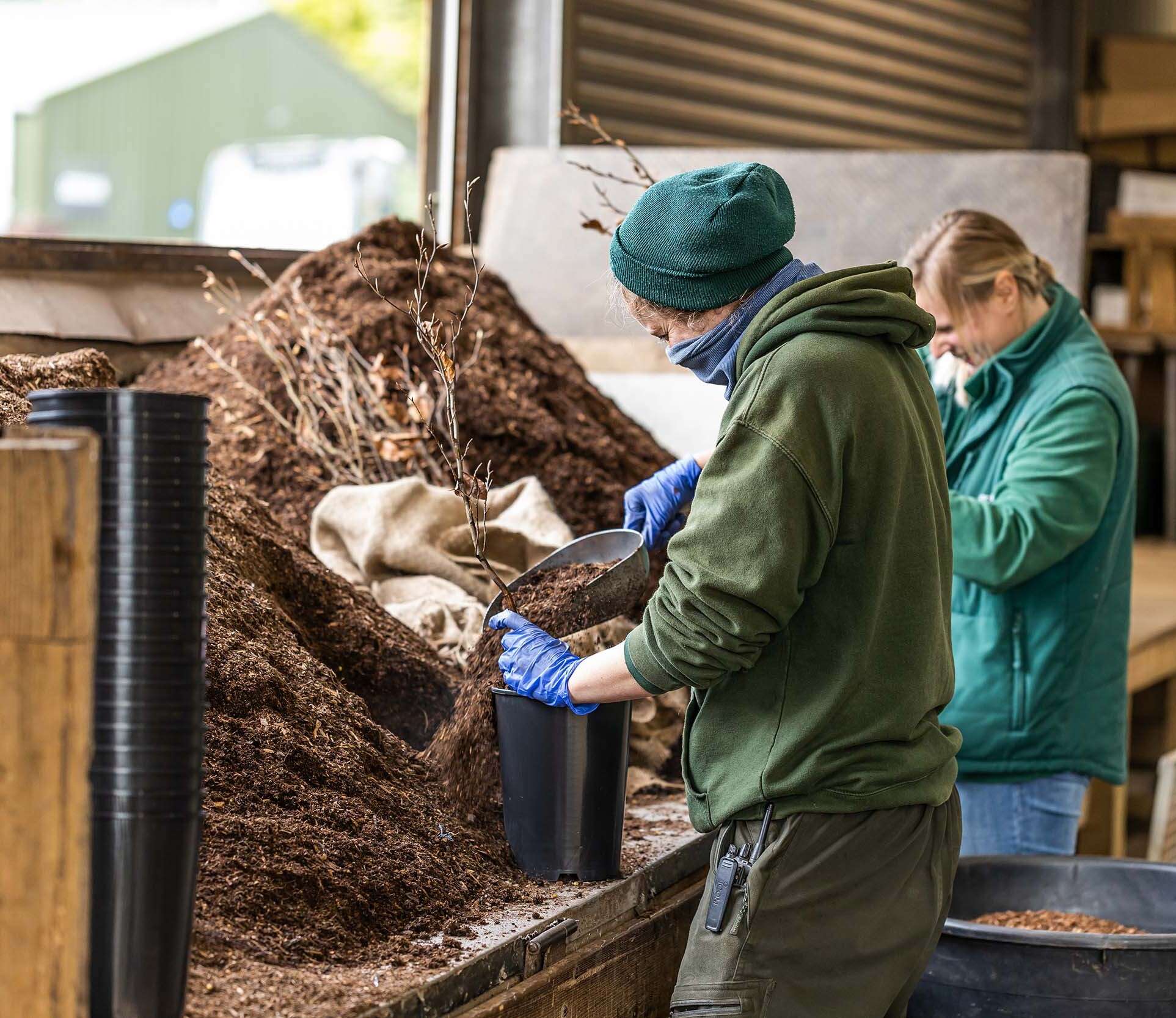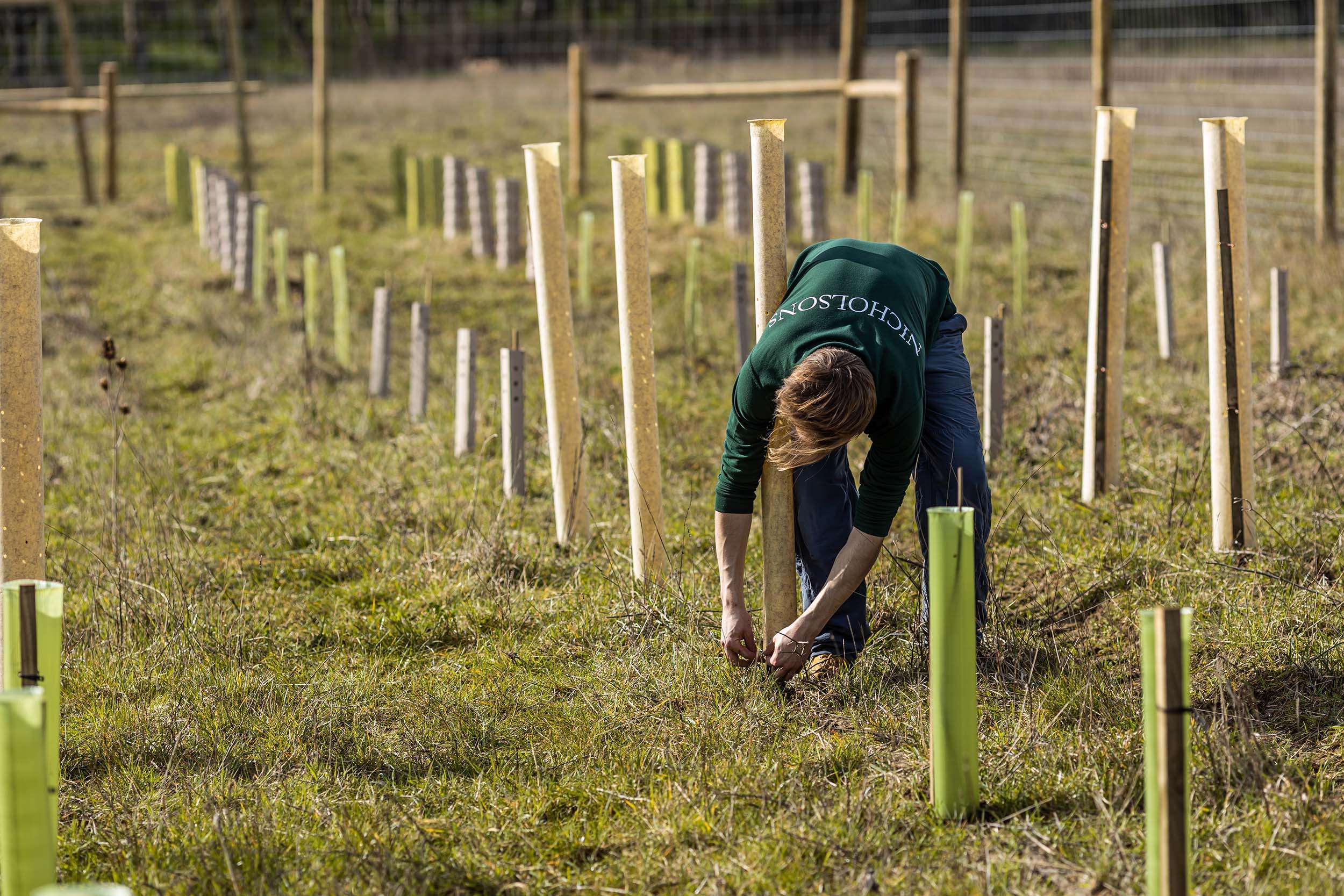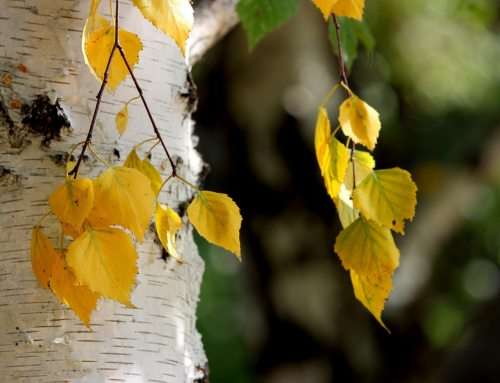Sustainability in Building the Natural Landscape
By Libby Reeves
It is so easy to think that any green space must be beneficial for the local environment, any tree to be planted must assist with the fight against carbon, and promoting everyone from individuals to large estates to add more plants must help our landscape to improve. This is, however, not the case. The forestry and horticultural industries are littered with methods and practices that are far more harmful to the environment than we would like to admit. In this week’s blog, I have tried to highlight a couple of these issues and how we are trying to correct this. This is so that we can plant more trees, hedges and borders with the satisfaction that we really can make a difference.

PLANNING
Careful planning of new gardens, hedges, woodland, or any other planting will have a huge impact on how beneficial it can be to the local area. A young tree can absorb some carbon, produce a few flowers for invertebrates, and create a few berries for birds and mammals. A mature tree can; absorb lots of carbon, produce masses of flowers, produce a huge amount of fruit, provide a habitat for lichen and moss, provide a home for all sorts of invertebrates, offer dead leaves for decomposers to live on, support for nesting birds and a hiding place for mammals, amphibians and many more. Trees take time to grow, so planting one with the opportunity to become mature has so many benefits. Ancient woodland is one of the most biodiverse habitats we have in this country, one which we have destroyed so frequently over the years. We cannot replace it overnight, but we can start to replant for the future.
To improve the planting we do, it is worth looking at our local area to see how we can expand this. A new build garden next to agricultural land could contain trees that we see in abundance in the local hedgerows. Using hawthorn, field maple, or hazel to pick a few will help the invertebrates that use these species as an extension of their home. Growing wildflowers in the borders, mimicking the flowers in the arable margins, will add nectar and food resources to the community that are already there. Surveying the area to be planted can promote the development of existing habitats. Chalk grassland is widely declining as it will degrade to scrubland so quickly, where scrubland is often overlooked for tree planting. If these sites are recognised before plans are made to develop them, we can promote the survival of the plants and animals that already live there.
PEAT-FREE
Peat has traditionally been extensively used in the growing industry. It allows for excellent development of young plants, thus creating the best quality trees to be planted in gardens, woodland and everything in between. The use of peat is, however, surrounded by controversy. Peat bogs are ancient habitats with huge and individual biodiversity. They also absorb huge amounts of carbon, particularly relative to the amount of space they take up. There is a lot of research being undertaken to promote the use of peat-free mediums, particularly waste products from other industries, with good success. The research is ongoing and new studies are constantly happening, with the mediums being improved all the time. There is plenty of peat-free growing medium available to the home gardener, our own Melcourt collection in the shop is all peat-free, including the Sylvagrow with added John Innes, the ideal peat-free solution to the traditional John Innes No. 3 many plants are grown in. The use of peat-free mediums in production horticulture is also starting to develop. Many nurseries, including Nicholsons, are becoming peat-free or at least reducing the amount of peat used, particularly for their trees and hedging. It is worth asking your plant supplier about their use of peat when building new gardens and the peat-free soil improvers available are excellent for improving soil structure without damaging these fragile habitats.

TREEGUARDS
Planting trees comes with the concern of allowing those trees to develop well without the added problem of pest damage. Rabbits, hares, and several types of deer are abundant in both the local area and nationwide, and they love to chew on freshly planted trees. There are a few methods we can use to protect our trees from initial failure. Planting the right tree in the right place will promote healthy growth. This, in turn, will allow the tree to grow away and become strong enough to withstand predator attack sooner than trees that struggle to establish. Understanding the local environment – the soil type, the exposure and the water levels – will aid this. Rabbit and deer fencing are ideal methods of protecting a larger area from attack. The level of fencing required depends on the species to be controlled: rabbit fencing needs to go underground, and deer netting needs to be tall enough that deer cannot jump in.

This, in turn, limits the requirement for individual tree guards, which can be a major source of single-use plastic in forestry and horticulture. There are some very good new biodegradable tree guards coming to the market and this is becoming a big area of research within forestry. The Woodland Trust is currently running a survey of many different types of guards, including cardboard, plant starch, polylactic acid, and one made of a mix of cashew nutshell, resin and wool. Currently, the cashew nut and wool mix is showing good early signs, but the tests are ongoing because a guard can only be considered reliable if it lasts up to 10 years. Kent county council are in the process of large-scale planting of new trees and has been testing cardboard tree guards on the south downs at Bluebell hill. One year into the project, the guards are showing signs of deterioration, but they are hoping they will last another year to give the trees a good start. The monitoring is still ongoing. Nicholsons are doing some large-scale tests of biodegradable tree guards, which are still ongoing, but the results of the first few years are looking positive. We are happy to say that we offer a biodegradable spiral guard in the Plant Centre.
Not for one moment do I think that I have covered all aspects of sustainability in building the natural landscape. Nicholsons already employ many additional practices to ensure we are being as sustainable as possible. For example, by limiting the use of concrete, using recycled materials for hard landscaping, moving away from black pots for growing in, and recycling growing pots and compost bags. Please pop in to discuss this further, and visit the Yurt which is proudly offering a sustainable, local menu.
REFERENCES
Circular alternatives to peat in growing media: A microbiome perspective. Taparia, Hendris, Nijhuis, de Boer and van der Wolf. Journal Of Cleaner Production. 327 2001
Kent county council website https://www.kent.gov.uk/environment-waste-and-planning/nature-and-biodiversity/trees/case-study-biodegradable-tree-guards#:~:text=Switching%20to%20biodegradable%20tree%20guards&text=This%20year%20the%20project%20has,and%20noting%20levels%20of%20decomposition.
Woodland trust website https://www.woodlandtrust.org.uk/about-us/what-we-do/research-and-evidence/plastic-tree-guards/





